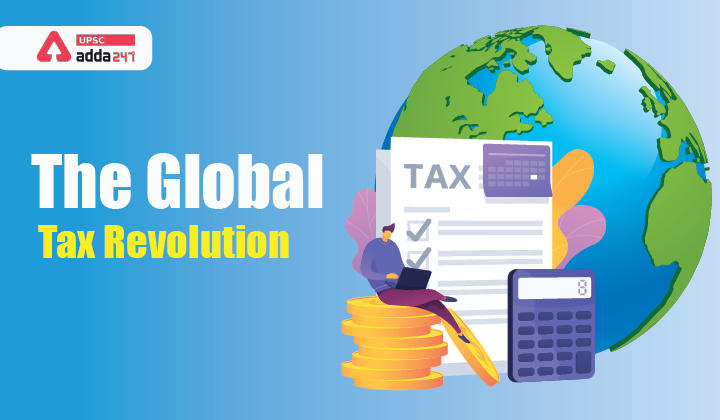Table of Contents
The Global Tax Revolution- Relevance for UPSC Exam
- GS Paper 3: Indian Economy- Issues relating to planning, mobilization of resources, growth, development and employment.
The Global Tax Revolution- Context
- Recently, International tax jurisprudence received a shot in the arm when 130 countries agreed to introduce a new global tax regime for taxing multinational corporations (MNCs) operating the globe over.
- For about a century, the corporate tax system was based on the application of the twin principles of the source rule and the residence rule.
- Earlier, the Global Financial Crisis of 2008 forced all countries to change the international tax rules to prevent base erosion and profit shifting.
New Quadrilateral Economic Forum- The Other Quad
The Global Tax Revolution- Reasons for Tax Evasion
- Globalization: Globalization allowed MNCs to replace fears of double taxation with the joy of double non-taxation by exploiting mismatches between the tax laws of various countries and by cutting taxable profits.
- Digitization: With the digitized world, it became easier for companies to avoid taxes by shifting their profits to either a non-tax regime or a low-tax regime.
- Coming up of tax heaven jurisdictions: MNC in order to avoid high tax in a country where they did business, get registered in a tax haven jurisdiction.
- Tax havens came in handy for the MNCs. It became easier with the rise of intangible assets, which could easily be shifted from one country to another.
The Editorial Analysis: An emigration Bill that does not go far enough
The Global Tax Revolution- Impact of Tax Evasion
- Loss of Revenue: shifting of profits to low tax havens deprives poor countries of revenue by as much as 5% as compared to an alternative system where profits are taxed based on the current location of companies, revenues, their employees and their wage codes.
- OECD estimates: proposal to levy 15% minimum tax on global corporations that do business in each country would fetch an additional $150 billion per year and move taxing rights of over $100 billion in profits to different countries.
Failing on Food- Status of Malnutrition in Children and PM POSHAN Scheme
The Global Tax Revolution- Steps taken by countries
- Introduction of Digital services Tax: Countries like Belgium, Britain, India and Indonesia brought in Digital Services Taxes on the local sales of foreign firms with online platforms.
- The U.S. objected and threatened retaliatory tariffs.
- Global Tax Regime: Recently, led by Organization for Economic Co-operation and Development (OECD), 130 countries achieved a historic agreement for a more stable and fairer international tax architecture.
Social and Emotional Learning- Empathy Through Education
The Global Tax Revolution- Key Features of new Global Tax Regime
- As per the agreement, MNCs would no longer pay taxes in the country where they register their headquarters for tax purposes but would pay in the country where they generate their sales.
- Introduction of a minimum global tax: A tax of 15% on profits would be introduced in all countries.
- Taxing Mechanism: Taxing rights would be reallocated so that a slice of the profits could be levied according to the location of a company’s sales.
- A minimum rate of 15% would be levied on such a slice of profits.
- Right to Tax: As per the agreement, countries, where MNCs operate, would get the right to tax at least 20% of the profits exceeding a 10% margin.
- Agreed Objectives:
- Anti-abuse provisions,
- New transfer pricing documentation provisions,
- Countering harmful tax practices more effectively taking into account transparency and economic substance and
- Introduction of an effective dispute resolution mechanism
The Global Tax Revolution- India’s Stand on New Global Tax Regime
- India, China, Russia, Germany and other countries have signed the agreement, which has to be implemented from 2023.
- Associated Issues for India:
- India would have to reconsider the equalization levy. Revenue from the equalization levy should be compared with the 15% global minimum tax.
- Concerns such as the share of profit allocation and the scope of subject-to-tax rules would have to be addressed before signing the agreement.
- Revamping India’s Direct Tax Code to sail with the concept of global minimum tax requires effort, which is easier said than done.
The All-India Quarterly Establishment-based Employment Survey
The Global Tax Revolution- Conclusion
- Simultaneous implementation of the law by all the signatories to the agreement would be a stupendous job. If achieved, it may herald the dawn of the ‘Golden Era’ of direct taxes.




 TSPSC Group 1 Question Paper 2024, Downl...
TSPSC Group 1 Question Paper 2024, Downl...
 TSPSC Group 1 Answer key 2024 Out, Downl...
TSPSC Group 1 Answer key 2024 Out, Downl...
 UPSC Prelims 2024 Question Paper, Downlo...
UPSC Prelims 2024 Question Paper, Downlo...
